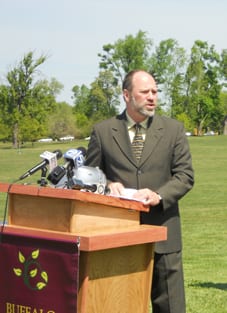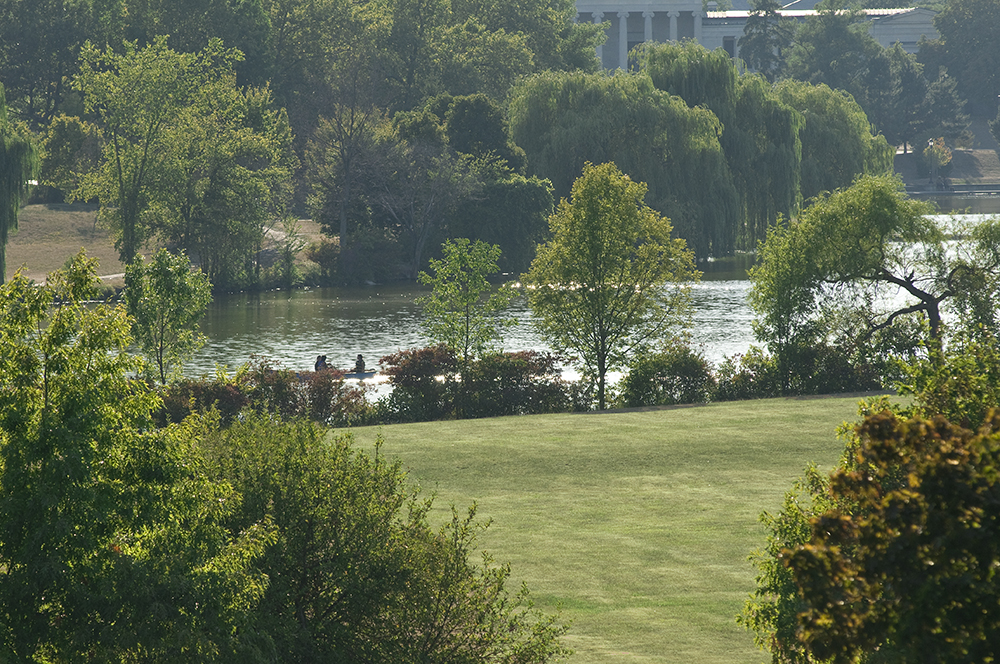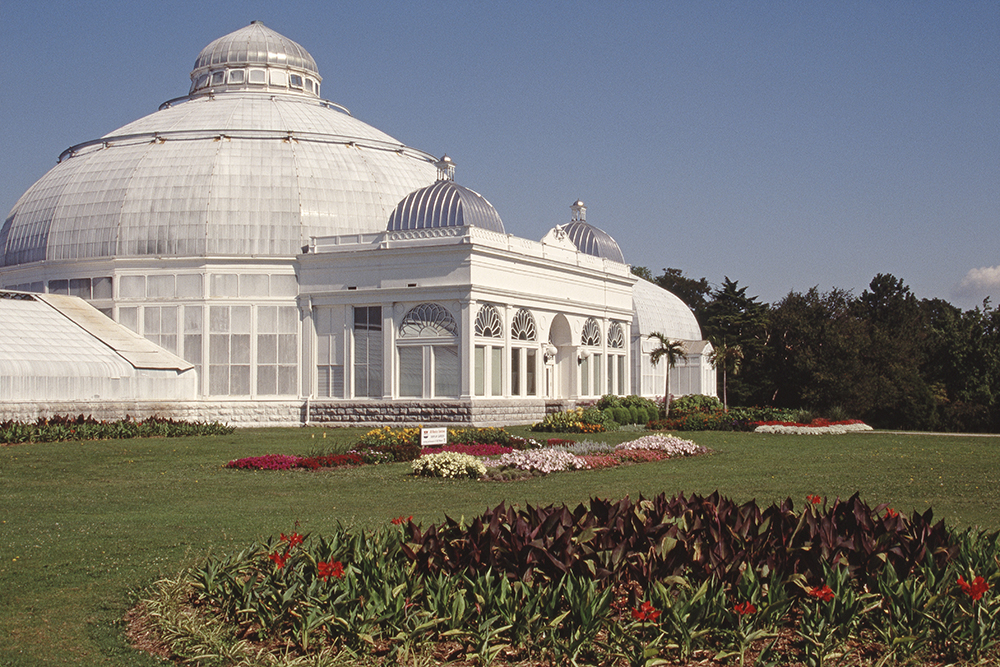Thomas Herrera-Mishler, Buffalo, New York (2013)

“Buffalo has been such a discovery,” says Mexican-born landscape architect Thomas Herrera-Mishler five years after moving with his family from Wellesley, Massachusetts, to work for the Buffalo Olmsted Parks Conservancy. “It has turned out to be such an interesting place, with so much to offer,” says Herrera-Mishler, who is now the organization’s president and CEO. Frederick Law Olmsted named Buffalo the “Best Planned City in the World”—the LALH book about the design of the city’s green infrastructure has the same title—after he designed Buffalo’s park and parkway system as an integral part of the city in 1868 with Calvert Vaux. For Herrera-Mishler, who is drawn to historic landscapes and public service, Buffalo holds particular interest—and gravitas.
Herrera-Mishler grew to admire Olmsted while he was studying for his master’s degree in landscape architecture and regional planning at the University of Michigan in the mid-1980s. After completing his MLA he went on to work on projects of various scales in the United States and abroad—including the master plan for the National Zoo and Botanical Garden of Costa Rica. Then, in 1992, Herrera-Mishler moved into the nonprofit sector after a life-changing experience in Philadelphia. “I was invited by an old friend of the family to work with his organization there for a year, serving the abandoned poor,” he explains. “My wife and I were live-in staff at a home for schizophrenic homeless women. During the day, I ran a house for men in recovery from addiction, and my wife [the Honorable Mercedes Herrera Rojas de Mishler] ran a shelter for active addicts. She was then a diplomat from Costa Rica, and we were part of this, heart and soul, together.”

Before, during, and after that year, Herrera-Mishler built five community gardens in a neighborhood he describes as “desperately poor.” “I also got to build a children’s garden,” he says. “We and the children painted a mural together, and that started a transformation in the community that continues today.” Such experiences proved so meaningful that after his year of working with the homeless he decided to explore how he could bring his skills to the nonprofit sector.
Working next for the Pennsylvania Horticultural Society as their Philadelphia Green community landscape architect, he led the development of vacant land reuse strategies with nonprofit community development corporations that provide programs and services in low-income neighborhoods. Then, at Awbury Arboretum in the city’s Germantown neighborhood, he learned about historic landscape preservation and fundraising, for which he developed a flair. “I enjoy it, because the money makes great things happen, and I have seen how important it is to develop relationships with people who understand the mission of your organization—it’s about mutual trust and respect.”

Herrera-Mishler served as executive director of the Toledo Botanical Garden in Ohio and later of the Massachusetts Horticultural Society. In between, he was director of Airlie Gardens in Wilmington, North Carolina, where he invited local artists to commemorate the African American outsider artist Minnie Evans (1892–1987), who formerly painted and worked on the property. As their tribute to Evans, the artists created a sculpture garden and a chapel made of colored-glass bottles, now a popular attraction that has kindled a growing local focus on cultural tourism. Herrera-Mishler says, “That experience taught me to celebrate diversity and to cultivate partnerships between art and garden organizations, which are a natural fit.”

Buffalo’s parks are benefiting from Herrera-Mishler’s past experience. The Buffalo Olmsted Parks Conservancy has reached out to businesses and other nonprofit organizations to recruit volunteers and muster millions of dollars for park rehabilitation and related community development programs. In a city that still struggles with poverty and a shabby self-image, he views the elaborate system of parks and parkways, still largely intact, as a roadmap for community revitalization. For instance, the Buffalo park system’s anchor landscape, Delaware Park, now hosts nearly two million visitors each year. The park is also the site of the Art in the Garden Fair that launches the two-month-long National Garden Festival. “Buffalo has a unique artistic legacy, and we combine it with our many garden walks, which open hundreds of private gardens to the public in the city and surrounding communities during June and July,” he says. “I’m really excited about this partnership, which also involves the Western New York State Nursery and Landscape professionals and the Buffalo and Erie County Botanical Gardens. Partnerships are where it’s at—everybody wins.”
Herrera-Mishler also tapped the nursery and landscape professionals’ group for an event called the Buffalo Garden Makeover. “We are rehabilitating the Olmsted parks communities one by one,” he says. For each of the past three years the conservancy has chosen one of its parks, gone to homeowners whose properties border it, “and offered to make over their front yards,” he says. “We are a very poor city, and if you say to people, ‘We’re going to give you a new front yard, with all the plants and tools and hoses, and teach you how to take care of it,’ they’re thrilled.” The program, says Herrera-Mishler, results in stunning new streetscapes surrounding the restored parks. “These spruced-up front yards are now real places of community pride, and they’ve inspired other residents to make similar improvements.”
These successes appear nearly miraculous against a backdrop of past “decline, neglect, and abuse” under past city governments that did not make maintaining the park system a priority, says Herrera-Mishler. For the past nine years, the Buffalo Olmsted Parks Conservancy has been charged with the ongoing maintenance and operations of the parks, working closely with the city in a productive public-private partnership. He credits the friends group that formed in 1978 and evolved into the present conservancy—and also helped launch the National Association of Olmsted Parks, of which Herrera-Mishler is a board member—for starting the turn-around. “They saw the potential of transforming the entire green infrastructure of the city and celebrating the design genius of Olmsted.”

Outreach to neighborhoods in this multicultural city has been enhanced by the diversity of the conservancy staff (38 percent nonwhite) and a broad volunteer base: 2,200 people, from trustees to clean-up crews, contribute $1 million worth of labor annually. To augment the number of gardeners throughout the park system, the conservancy manages a seasonal workfare program that employs immigrants, 80 percent of whom return each year. Among the conservancy’s employees are two other landscape architects, a preservation architect, and an archivist. The archive, assembled while Herrera-Mishler has been in charge, contains thousands of documents, plans, and photographs related to the history of the parks and the broader Olmsted legacy. “Through them, we’re discovering what a rich story we have,” he says.
—Jane Roy Brown, former LALH Director of Educational Outreach.
More on the Buffalo Park System
Book: The Best Planned City in the World: Olmsted, Vaux, and the Buffalo Park System by Francis R. Kowsky
Film: The Best Planned City in the World: Olmsted, Vaux, and the Buffalo Park System